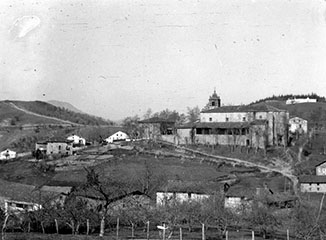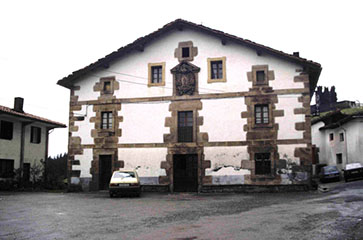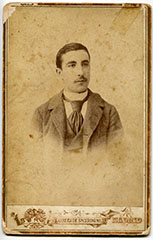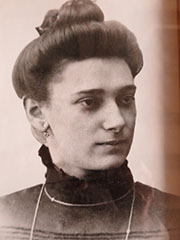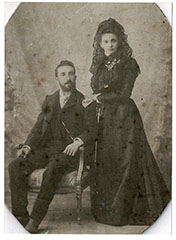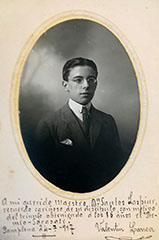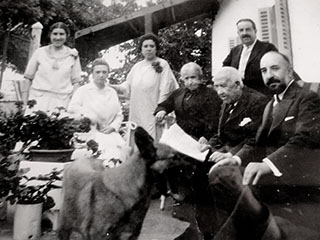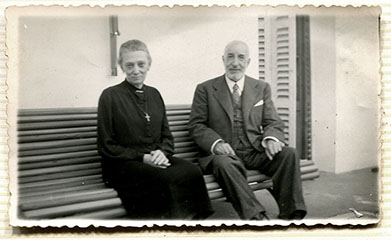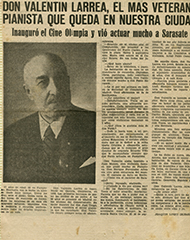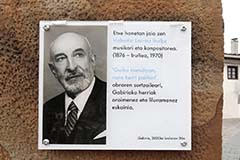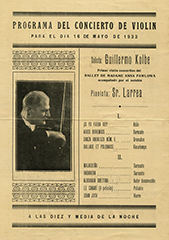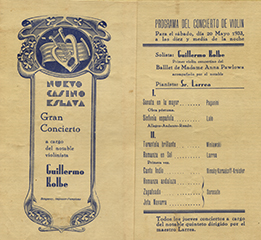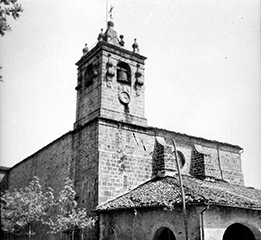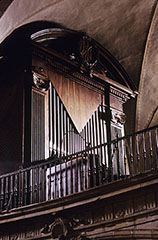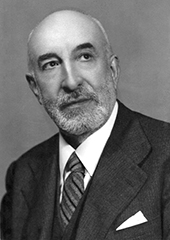VALENTIN LARREA ITURBE (Gabiria, 1876 – Iruñea, 1970)
The pianist and composer Valentin Larrea Iturbe was born in Gabiria, in the province of Gipuzkoa, on the 27th of December 1876, and was the first of five siblings. His parents, Tecla Iturbe Balentziategi (Ormaiztegi, Gipuzkoa) and Meliton Larrea Perez de Lazarraga (Zalduondo, Araba) got married in Gabiria in 1875. His father was the organist of the local church as well as a teacher in the local schools. He also worked as a town clerk, which is why the family resided in the town hall. This is where Valentin lived for the first few years of his life, before the family moved to their next residence, Larrea-Enea.
Valentin stood out from an early age thanks to his musical prowess, and began to learn music theory and organ playing with his father. Once they had become aware of their son’s affinity for music, his parents decided he should undertake musical studies in Madrid; and so on October of 1893, at 17 years of age, Valentin enrolled in the Escuela Nacional de Música y Declamacion (National College of Music and Declamation). He was taught by the most recognised and distinguished proffesors at the time: Tragó for piano, Arín for harmony, Serrano for composition and Jimeno de Lerma for organ.
He completed his studies in the most brilliant manner, achieving the best grades, and he obtained multiple first awards in public competitive examinations, according to his academic curriculum.
In Madrid he also met Teresa Auzmendi Aranburu, who would later be his wife. She was originally from Beasain, but was living in the capital with her maternal aunts.
After completing his studies, he learnt through the press in Madrid that there was an opening for the position of head pianist at the Nuevo Casino Eslava in Pamplona. The public competition examination for the position took place in February of 1898, and Valentin obtained the position unanimously, after which he moved to Pamplona to begin his profesional career.
1900eko urriaren 19an, Valentin eta Teresa ezkondu egin ziren. Txapitela kaleko 12.enean zeukaten etxea, eta bertan sortu zuten familia. Bost seme-alaba izan zituzten, eta haietatik bi haurrak zirela hil ziren. Seme zaharrenak, Valentin Larrea Auzmendik (Iruñea, 1901- Buenos Aires, Argentina, 1982), aitaren ildo beretik jarraitu zuen: musika eta pianoa ikasi zuen Iruñeako Kontserbatorioan, eta oso gazterik nabarmendu zen piano-jotzaile gisa. 13 urterekin kontzertuak ematen hasi zen, eta 16rekin Iruñeko Sarasate saria irabazi zuen. Argentinara joan zen gero, eta Buenos Aires hirian egin zuen ibilbide musikala.
Valentin and Teresa got married on the 19th of October, 1900. They moved into house 12 on Chapitela Street, where they formed their family. They gave birth to five sons, two of which died at an early age. The eldest, Valentin Larrea Auzmendi (Pamplona, 1901 – Buenos Aires, Argentina, 1982) followed his father’s footsteps: he completed studies in music and piano at Conservatorio de Pamplona, and stood out as a great pianist from an early age. He began performing in concerts at the age of 13, and at the age of 16 he was given the Premio Sarasate. He later moved to Argentina, and developed his musical career in Buenos Aires.
Valentin was an influential figure in the cultural landscape of Pamplona. He was founder and first tenor of the Orfeón Pamplonés (Pamplona choral society), and composed works expressly for this group. Seeing him playing the piano and the organ at musical events was a common sight; and of course, he always took part in the annual concert for San Fermín. In 1923 he inaugurated the Olimpia cinema with a composition written for the occasion. He was a frequent atendee at the Gayarre theatre, where he held a season ticket. In 1967, when the theatre acquired a grand piano, Valentin took care of the sound checks.
Despite having moved to Pamplona, Valentin never lost touch with his origins and he always felt very connected to Gabiria. He was always involved in the local festivities, during which he would deliver piano concerts at the Larrea-Enea family home or play the organ at the church services. He compose the piano pieces Goiko mendiyan and Nere herri politari in honour of Gabiria, and in 1912 he composed the concert march La perla del océano for the inauguration of the new schools in the locality. Valentin also had a tight bond with Zarautz, as his daughter Maria Luisa Larrea Auzmendi (Pamplona, 1908 – Zarautz, 2005) and her husband Jose Maria Berazadi Garate (Zarautz, 1901 – 1983) resided there. Valentin would often visit Zarautz t osee his children and grandchildren.
In 1948 he was awarded the Medalla del Trabajo for his 50 years as pianist in the Nuevo Casino Eslava. The Santa Cecilia orchestra performed under the masterful baton of Valentin at the tribute paid to him on the occasion of his reitrement. Two of his own compositions featured in that concert: Andante en do eta Adagio.
Valentin Larrea died in his house in Pamplona on the 9th of May, 1970, at the age of 93, after an entire life dedicated to music. He continued composing until his last days, which showcases the love he held for the art.
In 2020, on the 50th anniversary of Valentin's death, a commemorative plaque was placed on his natal house, and a concert featuring his most popular string instrument compositions was held at the church. The Berazadi Larrea family were responsible for the promotion of the event, with the help of the Gabiria town council and the Gipuzkoa provincial council.
PROFESSIONAL CAREER
Alongside being the head pianist at the Nuevo Casino Eslava, Valentin also delivered piano lessons and offered many concerts.
He was an excellent pianist, who stood out thanks to his refined technique and great sensitivity. These qualities gave his performances a very personal brilliance and warmth.
For 18 years he was a member of the prestigious Aramendia quintet, formed by Felipe Aramendia. The performances of the Aramendia quintet at Café Iruña were widely celebrated, as well as the concerts they gave during the summer seasons between 1912 and 1921 at the Hotel Continental in San Sebastian. They would also perform every year at the party in the palace of Santillana in Zarautz, home of the Duke of the Infantado, where the King of Spain would come for visits.
He accompanied acclaimed violinists on the piano during his career, with big names such as Guillermo Kolbe and Antonio Alvira among the highlights.
He composed many pieces for piano: preludes, waltzes, pieces inspired by Basque folklore, Spanish music… Of all his compositions, 43 have been preserved.
The variety of symphonic works and chamber music written by Valentin Larrea also demonstrate his quality as a truly gifted composer. His 14 known compositions for strings cover all ensembles: quartets, quintets, chamber orchestras and so on. Unfortunately many of his other pieces have been lost and their whereabouts remain a mystery.
Pieces for organ and religious music
Valentin's first contact with music came through his father, who was also an organ player himself. Therefore, the Gabiria church organ had a great impact in his musical beginnings, and he wrote his first compositions for the organ while studying in Madrid. Valentin Larrea was profoundly religious, and the organ provided a Gateway to express these deeply religious feelings. He also used it as a tool to express his love for his family. 13 compositions for organ and organ and voice ensembles remain, as well as a solemn mass and a kyrie.
Choir music and compositions for groups of txistularis
At the end of the 19th century, the Diputación Foral de Gipuzkoa (Gipuzkoa provincial council) took charge of the Juegos Florales Vascos, which were created and sponsored by Anton Abadia in 1851.
And so in 1893 the first Fiestas Euskaras were celebrated in Azpeitia, a tradition that continued annually for the next 18 years across multiple towns in the province of Gipuzkoa. They were riddled with all kinds of artistic competitions: poetry, spoken verse, music, choral music… They turned out to be fantastic events for composers and artists to showcase their artistic creations, and the winners were rewarded with fame and cash prizes.
Valentin was a frequent participant in the Fiestas Euskaras, and he won multiple prizes for his compositions for piano, choir and groups of txistularis: in Zumaia (1900), Azpeitia (1901), Irun (1902), Donostia – San Sebastian (1903), Ordizia (1904), Bergara (1905), Donostia – San Sebastian (1906), Elgoibar (1907), Donostia – San Sebastian (1911)...
In 1903 he remained out of the competition after having obtained the first prize for three consecutive years. His choir pieces became part of the standard repertoire of the Orfeón Pamplonés.
He very successfully participated in many other musical events:
- In 1902 he obtained the first prize in the musical competition of the Ateneo de Bilbao with his composition Gure arbol santuari obrarengatik.
- In 1903 he was special mention at the El Heraldo de Madrid contest for the set of waltzes for string orchestra titled Sueño de amor (Tomás Bretón, Ruperto Chapí and Gerónimo Gimeno formed part of the jury).
- In 1904 he was awarded the Circulo de Bellas Artes de Madrid prize for his set of waltzes for string orchestra titled Bellas artes.
- In 1930 he was awarded the first prize in the Ayuntamiento de Irun musical competition for his piano composition Seis preludios vascos.
- In 1946 he was awarded the first prize in the Ayuntamiento de Pamplona literary-musical contest for his piano composition titled Cuatro preludios inspirados en melodías populares navarras.
The work of Valentin Larrea is collected in the Eresbil basque music archives and the Archivo de Música y Artes Escénicas de Navarra (archive for music and scenic arts of Navarre).
